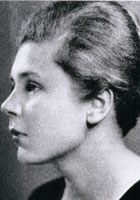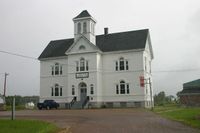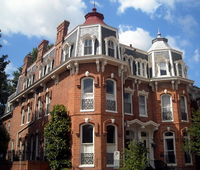Elizabeth Bishop
| Elizabeth Bishop | |
|---|---|
 Elizabeth Bishop at Vassar |
|
| Born | February 8, 1911 Worcester, Massachusetts, USA |
| Died | October 6, 1979 (aged 68) Boston, Massachusetts, USA |
| Occupation | Poet |
| Nationality | United States |
| Literary movement | Modernism |
| Partner(s) | Lota de Macedo Soares (1952-1967) Alice Methfessel (1971-1979) |
|
Influences
Marianne Moore
|
|
Elizabeth Bishop (8 February 1911 – 6 October 1979) was an American poet. She was the Poet Laureate of the United States from 1949 to 1950, a Pulitzer Prize winner in 1956 and a National Book Award Winner for Poetry in 1970. Elizabeth Bishop House is an artist's retreat in Great Village, Nova Scotia dedicated to her memory. She is considered one of the most important and distinguished American poets of the 20th century. [1]
Contents |
Biography
Early years
Elizabeth Bishop was born in Worcester, Massachusetts. After her father, a successful builder, died when she was eight months old, Bishop’s mother became mentally ill and was institutionalized in 1916. Bishop would later write about the time of her mother's struggles in her short story "In The Village." Effectively orphaned during her very early childhood, she lived with her grandparents on a farm in Nova Scotia, a period she would later reference in her writing. Bishop's mother remained in an asylum until her death in 1934, and the two were never reunited.[2]
Later in childhood, Bishop's paternal family gained custody and she was removed from the care of her grandparents and moved in with her father's much wealthier family in Worcester, Massachusetts. However, Bishop was very unhappy in Worcester and her separation from her grandparents made her very lonely. It's also significant to note that while she was living in Worcester, she developed chronic asthma which she would suffer from for the rest of her life. This time in her life is briefly chronicled in her poem "In The Waiting Room."
Bishop boarded at the Walnut Hill School in Natick, Massachusetts, where her first poems were published by her friend Frani Blough in a student magazine.[3] Then she entered Vassar College in the fall of 1929, shortly before the stock market crash. In 1933, she co-founded Con Spirito, a rebel literary magazine at Vassar, with writer Mary McCarthy (one year her senior), Margaret Miller, and the sisters Eunice and Eleanor Clark.[4]
Bishop's Influences

Bishop was greatly influenced by the poet Marianne Moore[5] to whom she was introduced by a librarian at Vassar in 1934. Moore took a keen interest in Bishop’s work, and at one point Moore dissuaded Bishop from attending Cornell Medical School, in which the poet had briefly enrolled herself after moving to New York City following her Vassar graduation. It was four years before Bishop addressed ‘Dear Miss Moore’ as ‘Dear Marianne,’ and only then at the elder poet’s invitation. The friendship between the two women, memorialized by an extensive correspondence (see One Art), endured until Moore's death in 1972. Bishop's "At the Fishhouses" (1955) contains allusions on several levels to Moore's 1924 poem "A Grave." [6]
She was introduced to Robert Lowell by Randall Jarrell in 1947 and they would become great friends, mostly through their written correspondence, until Lowell's death in 1977. After his death, she wrote, "our friendship, [which was] often kept alive through years of separation only by letters, remained constant and affectionate, and I shall always be deeply grateful for it"[7]. They also both influenced each other's poetry. Lowell cited Bishop's influence on his poem "Skunk Hour" which he said, "[was] modeled on Miss Bishop's 'The Armadillo.'"[8] Also, his poem "The Scream" is "derived from...Bishop's story In the Village."[9] "North Haven," one of the last poems she published during her lifetime, was written in memory of Lowell in 1978.
Travels and awards
Bishop was independently wealthy in early adulthood as a result of an inheritance from her deceased father that didn't run out until the end of her life. With this inheritance, Bishop was able to travel widely without worrying about employment and lived in many cities and countries which are described in her poems.[10] She lived in France for several years in the mid-1930s with a friend she knew at Vassar, Louise Crane, who was a paper-manufacturing heiress. In 1938 Bishop purchased a house with Crane at 624 White Street in Key West, Florida. While living there Bishop made the acquaintance of Pauline Pfeiffer Hemingway, who had divorced Ernest Hemingway in 1940.

In 1946, Marianne Moore suggested Bishop for the Houghton Mifflin Prize for poetry, which Bishop won. Her first book, North & South, was published in 1,000 copies. The book prompted the literary critic Randall Jarrell to write that “all her poems have written underneath, 'I have seen it,'" referring to Bishop's talent for vivid description.[11]
Upon receiving a substantial (at the time) $2,500 traveling fellowship from Bryn Mawr College in 1951, Bishop set off to circumnavigate South America by boat. Arriving in Santos, Brazil in November of that year, Bishop expected to stay two weeks—but stayed fifteen years.
While living in Brazil, in 1956 Bishop received the Pulitzer Prize for a collection of poetry, Poems: North & South/A Cold Spring, which combined her first two books. [12] It was also during her time in Brazil that Elizabeth Bishop became increasingly interested in the languages and literatures of Latin America. [13] She translated into English and was influenced by South and Central American poets, including the Mexican poet, Octavio Paz, as well as the Brazilian poets João Cabral de Melo Neto and Carlos Drummond de Andrade, of whom she said, "I didn't know him at all. He's supposed to be very shy. I'm supposed to be very shy. We've met once — on the sidewalk at night. We had just come out of the same restaurant, and he kissed my hand politely when we were introduced."[14]
In addition to winning the Pulitzer Prize, Bishop also won the National Book Award and the National Book Critics Circle Award as well as two Guggenheim Fellowships and an Ingram Merrill Foundation grant. In 1976, she became the first woman to receive the Neustadt International Prize for Literature, and remains the only American to be awarded that prize.[15]
Bishop lectured in higher education for a number of years starting in the 1970s when her inheritance began to run out[16]. For a short time she taught at the University of Washington, before teaching at Harvard University for seven years. She also taught at New York University, before finishing at the Massachusetts Institute of Technology. She often spent her summers in her summer house in the island community of North Haven, Maine.
In 1977, Bishop published her last book, Geography III, and two years later, she died of a cerebral aneurysm in her apartment at Lewis Wharf, Boston. She is buried in Worcester, Massachusetts.
Relationships
Although Elizabeth Bishop was involved in romantic relationships with women, she did not write about her personal life or her sexual orientation in her poetry and did not see herself as a "lesbian poet" or as a "female poet." She only wanted to be judged based on the quality of her writing and not on her gender or sexual orientation. [17]
Whereas many of her contemporaries like Robert Lowell and John Berryman made the intimate details of their personal lives an important part of their poetry, Bishop avoided this practice altogether. And Bishop's style of writing is particularly known for its objective, distant point of view.
Bishop had two long-term relationships with women. The first was with Brazilian socialite and architect Lota de Macedo Soares.[18] Soares was descended from a prominent and notable political family; the two lived as a couple for fifteen years. Although Bishop was not forthcoming about details, much of their relationship was documented in Bishop's extensive correspondence with Samuel Ashley Brown. However, in its later years, the relationship deteriorated, becoming volatile and tempestuous, marked by bouts of depression, tantrums and alcoholism.[19] Bishop had an affair with another woman and ultimately left Lota and returned to the United States. Soares, suffering from depression, followed Bishop to America and committed suicide in 1967.[20]The second relationship was with Alice Methfessel, whom Bishop met in 1971, beginning a relationship with her. Methfessel became Bishop's partner and, after her death, her literary executor. [21]
Works by Bishop
- Poetry collections
- North & South (Houghton Mifflin, 1946)
- Poems: North & South/A Cold Spring (Houghton Mifflin, 1955)
- A Cold Spring (Houghton Mifflin, 1956)
- Questions of Travel (Farrar, Straus, and Giroux, 1965)
- The Complete Poems (Farrar, Straus, and Giroux, 1969)
- Geography III, (Farrar, Straus, and Giroux, 1976)
- The Complete Poems: 1927-1979 (Farrar, Straus, and Giroux, 1983)
- Edgar Allan Poe & The Juke-Box: Uncollected Poems, Drafts, and Fragments by Elizabeth Bishop ed. Alice Quinn, (Farrar, Straus, and Giroux, 2006)
- Other works
- The Diary of Helena Morley, by Alice Brant, translated and with an Introduction by Elizabeth Bishop, (Farrar, Straus, and Cudahy, 1957)
- The Ballad of the Burglar of Babylon (Farrar, Straus, and Giroux, 1968)
- An Anthology of Twentieth Century Brazilian Poetry edited by Elizabeth Bishop and Emanuel Brasil, (Wesleyan University Press (1972)
- The Collected Prose (Farrar, Straus, and Giroux, 1984)
- One Art: Letters selected and edited by Robert Giroux, (Farrar, Straus, and Giroux, 1994)
- Exchanging Hats: Elizabeth Bishop Paintings, edited and with an Introduction by William Benton, (Farrar, Straus, and Giroux, 1996)
- Poems, Prose and Letters Robert Giroux and Lloyd Schwartz, eds. (New York: Library of America, 2008)
- Words in Air: The Complete Correspondence Between Elizabeth Bishop and Robert Lowell, ed. Thomas Travisano, Saskia Hamilton (Farrar, Strauss & Giroux, 2008)
- Conversations with Elizabeth Bishop . George Monteiro Ed. (University Press of Mississippi 1996)
Awards and honors
- 1945: Houghton Mifflin Poetry Prize Fellowship
- 1947: Guggenheim Fellowship
- 1949: Appointed Consultant in Poetry at the Library of Congress
- 1950: American Academy of Arts and Letters Award
- 1951: Lucy Martin Donelly Fellowship (awarded by Bryn Mawr College)
- 1953: Shelley Memorial Award
- 1954: Elected to lifetime membership in the National Institute of Arts and Letters
- 1956: Pulitzer Prize for Poetry
- 1960: Chapelbrook Foundation Award
- 1964: Academy of American Poets Fellowship
- 1968: Ingram-Merrill Foundation Grant
- 1969: National Book Award
- 1969: The Order of the Rio Branco (awarded by the Brazilian government)
- 1974: Harriet Monroe Poetry Award
- 1976: Books Abroad/Neustadt International Prize
- 1976: Elected to the American Academy of Arts and Letters
- 1977: National Book Critics Circle Award
- 1978: Guggenheim Fellowship
References
- ↑ Originally published in the April/ May 1998 issue of Boston Review Retrieved 2008-04-25.
- ↑ "Elizabeth Bishop". Worcester Area Writers. Worcester Polytechnic Institute. http://www.wpi.edu/Academics/Library/Archives/WAuthors/bishop/bio.html. Retrieved 2008-04-25.
- ↑ "Elizabeth Bishop". Walnut Hill School. http://www.walnuthillarts.org/creative_writing/elizabeth_bishop.html. Retrieved 2008-04-25.
- ↑ "Elizabeth Bishop, American Poet". Elizabeth Bishop Society. Vassar College. http://projects.vassar.edu/bishop/. Retrieved 2008-04-25.
- ↑ Kalstone, David. Becoming a Poet: Elizabeth Bishop with Marianne Moore and Robert Lowell. University of Michigan Press (2001): 4. In an early letter to Moore, Bishop wrote: "[W]hen I began to read your poetry at college I think it immediately opened up my eyes to the possibility of the subject-matter I could use and might never have thought of using if it hadn't been for you. — (I might not have written any poems at all, I suppose.) I think my approach is so much vaguer and less defined and certainly more old-fashioned — sometimes I'm amazed at people's comparing me to you when all I'm doing is some kind of blank verse — can't they see how different it is? But they can't apparently."
- ↑ Stewart, Susan (2002) Poetry and the Fate of the Senses. University of Chicago Press 141, 357 fn.78 and fn.79).
- ↑ Bishop, Elizabeth. Poems, Prose, and Letters. New York: Library of America, 2008. 733.
- ↑ Lowell, Robert (2003) Collected Poems New York: Farrar, Straus, and Giroux, p1046.
- ↑ Lowell, Robert. (2003) Collected Poems New York: Farrar, Straus, and Giroux p326.
- ↑ [www.poets.org/poet.php/prmPID/7 biog Retrieved 2008-04-25]
- ↑ Jarrell, Randall (2002) Poetry and the Age University Press of Florida p. 181
- ↑ Pulitzer listing Retrieved 2008-04-25
- ↑ Schwartz and Estess (1983) p236
- ↑ Schwartz and Estess (1983) p329
- ↑ Neustadt International Prize for Literature listing Retrieved 2008-04-25
- ↑ Schwartz, Tony. Elizabeth Bishop Won A Pulitzer for Poetry and Taught At Harvard. New York Times 8 October 1979: B13 NYT article Retrieved 2008-04-25
- ↑ Kalstone, David and Hemenway, Robert (2003) Becoming a Poet: Elizabeth Bishop with Marianne Moore and Robert Lowell. Ann Arbor: University of Michigan Press
- ↑ article The Love of Her Life June 2002 The New York Times review of Rare and Commonplace Flowers: The Story of Elizabeth Bishop and Lota de Macedo Soares Retrieved 2008-04-25
- ↑ Bishop Biography Retrieved 2008-04-25
- ↑ Oliveira, Carmen (2002) Rare and Commonplace Flowers: The Story of Elizabeth Bishop and Lota de Macedo Soares Rutgers University Press, ISBN 0-813-53359-7
- ↑ Random House essay by Ernest Hilbert Retrieved 2008-04-25
Bibliography
- Costello, Bonnie (1991). Elizabeth Bishop: Questions of Mastery. Cambridge: Harvard University Press. ISBN 0674246896.
- Kalstone, David (1989). Becoming a Poet: Elizabeth Bishop with Marianne Moore and Robert Lowell. New York: Farrar Straus Giroux. ISBN 0374109605.
- Millier, Brett (1993). Elizabeth Bishop: Life and the Memory of It. Berkeley: University of California Press. ISBN 0520079787.
- Oliveira, Carmen L. , trans Neil K. Besner, (2002) Rare and Commonplace Flowers: The Story of Elizabeth Bishop and Lota de Macedo Soares (Rutgers University Press, 2002) ISBN 100813533597
- Schwartz, Lloyd and Estess, Sybil P. (1983) Elizabeth Bishop and Her Art University of Michigan Press ISBN 10047206343X
- Travisano, Thomas (1988). Elizabeth Bishop: Her Artistic Development. Charlottesville: University Press of Virginia. ISBN 0813911591.
External links
- Works by or about Elizabeth Bishop in libraries (WorldCat catalog)
- Yale College Lecture on Elizabeth Bishop audio, video and full transcripts from Open Yale Courses. Retrieved 2008-04-25
- Links to Selected Elizabeth Bishop Poems Retrieved 2008-04-25
- The Elizabeth Bishop Papers at Washington University in St. Louis Retrieved 2008-04-25
- Elizabeth Bishop biog - Vassar College Retrieved 2008-04-25
- Elizabeth Bishop Centenary Retrieved 2010-04-08
- The Elizabeth Bishop Society of Nova Scotia Retrieved 2008-04-25
- Modern American Poetry, critical essays on Bishop's works. Retrieved 2008-04-25
- Works on Paper: the letters of Elizabeth Bishop and Robert Lowell The New Yorker 84/35 (3 November 2008) : 106-110 Retrieved 2008-04-25